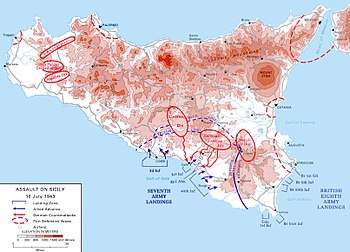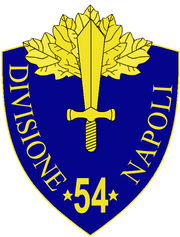54th Infantry Division Napoli
The 54th Infantry Division Napoli was a regular infantry division of the Italian Army during World War II. It was created 15 April 1939 in Caltanissetta and was dissolved 14 August 1943 in Melia southeast of Scilla, Calabria after being nearly wiped out in the Allied invasion of Sicily. The division drafted men in southern Sicily. The members of the division hailed from Caltanissetta, Agrigento, Syracuse and surrounding territories.

| 54th Infantry Division Napoli | |
|---|---|
 54th Infantry Division Napoli Insignia | |
| Active | 1939–1943 |
| Country | Italy |
| Branch | Italian Army |
| Type | Infantry |
| Size | Division |
| Garrison/HQ | Caltanissetta |
| Nickname(s) | Napoli |
| Engagements | World War II |
| Commanders | |
| Notable commanders | Generale di Divisione Giulio Porcinari[1] |
Action
In 1940, the Napoli division was deployed in southern Sicily, with major garrisons in Caltagirone, Piazza Armerina and Mirabella Imbaccari. In 1941 it was re-deployed with more emphasis on coastal defence, protecting a coastal strip Pozzallo-Gela-Licata.[2] In the anticipation of the Allied invasion of Sicily, the Napoli division was split into two groups: one group placed at Ramacca and Scordia, with the other group in Palazzolo Acreide, as part of the re-deployment of the Italian XVI Corps in Sicily. Before the allied landings even occurred, the division's headquarters at Palazzolo Acreide was bombed by the allied air forces on the night of 8 July.[3]
On the day of Allied landings, 10 July 1943, the Napoli engaged in fighting south of Noto, while the northern group fought at Lentini and Brucoli. As British superior forces attacked Floridia from the Ponte Diddino road, the Italian forces soon started to fail, despite heavy fighting on the mountaintop positions north of Solarino. On the second day of the campaign, 12 July 1943, the British captured Floridia and the entirety of the 75th Regiment as it was attempting to withdraw from the town.[4] Meanwhile, southern group of the division Napoli had made contact with an advancing battalion of the Durham Light Infantry on 12 July on the road between Palazzolo Acreide and Floridia. Its attacks, using infantry and five tanks, were repelled by British artillery and anti-tank fire.[5] By 12 July 1943, the division had managed to stabilize the front-line at Palazzolo Acreide-Solarino-Priolo Gargallo. By 13 July 1943, the new Allied landing north of Augusta had outflanked division, and inflicted heavy casualties to Napoli. Destruction continued on 14 July 1943, as remnants of division fought a rear-guard battle at Scordia to protect other units retreating from Caltagirone and Vizzini. It has been estimated that the division lost up to eighty-percent of its effectiveness soon after its initial opposition to the British landings,[6] The remnants of the Napoli Division were absorbed into the incoming Fallschirm-Panzer Division 1 Hermann Göring,[7] where they fought some small rearguard battles 16–24 July 1943. On 25 July 1943, the Napoli division tried to reform at Linguaglossa. But soon it became obvious that cut-off subunits were either destroyed or captured by the Allies, so the attempt to reform was abandoned and remaining personnel were ordered to Messina, where it was evacuated to Melia, southeast of Scilla 11–14 August 1943. The division was dissolved immediately after evacuation 14 August 1943.
Order of battle
- Headquarters
- Divisional Headquarters
- 1. Carabineri reali section
- 2. Carabineri reali section
- Artillery Headquarters
- Engineer headquarters
- Chief of staff
- Secret operations office
- Propaganda office
- Health office
- Police office
- Veterinary office
- 75. Infantry regiment "Napoli"
- Regimental headquarters company
- Command platoon
- Signal platoon
- Auxiliary platoon
- 3 infantry battalions
- Battalion headquarters company
- Command platoon
- Signal platoon
- Scout platoons
- 3 infantry companies
- Command platoon
- Command section
- Logistics section
- Fuel section
- 3 infantry platoons (18 men each)
- Command platoon
- Battalion headquarters company
- Close support mixed company
- Command platoon
- 2 machine gun platoons
- Mortar platoon (Brixia 45mm)
- Close support mortar company
- Command platoon
- 3 mortar platoons (da 81)
- Close support gun company
- Command platoon
- 4 gun platoons (47/32)
- Regimental headquarters company
- 76. Regiment. infantry "Napoli" (same composition as 75th regiment)
- 54. Artillery regiment "Napoli"
- Command office
- Command section
- Transport section
- 2 medium artillery groups
- Command office
- Command section
- Transport section
- 3 100/17 batteries
- Battery control section (4 men)
- Gun officers (6 men)
- 4 guns (24 crew)
- Machine gun section (2 machine guns, 7 men)
- Medical section (5 men)
- Transport section (11 men)
- Auxiliary staff (8 men)
- Command office
- 2 light artillery groups
- Command office
- Command section
- Transport section
- 3 Skoda 75 mm Model 15 batteries (same composition as 100mm batteries)
- 21a Anti-aircraft battery (8 Cannone-Mitragliera da 20/65 modello 35 (Breda))
- Command office
- Command office
- 173. CCNN Legion "Salso"
- 54. Mortar Battalion (da 81)
- 54. Machine Gun Battalion
- 54. Anti-Tank Company (47/32)
- 54. Engineer battalion
- 14. Mixed engineer company
- Command section
- Specialist platoon (bricklayers, cement layers, carpenters, blacksmiths, mechanics, electricians etc.)
- 2 combat engineer platoons (digging, road repair, stone cutting, minelaying, general work etc.)
- Transport company
- 54a Radio-telegraph company
- Telephone motorized platoon
- 2 telegraph motorized platoons
- Optical telegraph motorized platoon (8 optical telegraph stations with 80mm optics)
- Radio platoon (13 radio stations)
- Electro-optical telegraph motorized section
- 4 electro-optical telegraph stations
- 71a Engineer company
- 21a Combat engineer company
- 14. Mixed engineer company
- 1. Medical section
- 207. Field Hospital
- 851. Field Hospital
- 563a Supply Section[nb 1][7]
- 54. Motor Transport Section
- 729. Motor Transport Section
- 108. Light Motor Transport Section
- Mixed support platoon
- Medical section
- Supply section
- Heavy anti-tank gun
- 80a Carabineri office
Notes
- Footnotes
- An Italian Infantry Division normally consisted of two Infantry Regiments (three Battalions each), an Artillery Regiment, a Mortar Battalion (two companies), an Anti Tank Company, a Blackshirt Legion of two Battalions was sometimes attached. Each Division had only about 7,000 men, The Infantry and Artillery Regiments contained 1,650 men, the Blackshirt Legion 1,200, each company 150 men.[8]
- Citations
- Enrico Tagliazucchi and Franco Agostini. "Royal Italian Army". World War II Armed Forces – Orders of Battle and Organizations. Archived from the original on 4 April 2009. Retrieved 4 May 2009.
- http://www.regioesercito.it/reparti/fanteria/rediv54.htm
- Mitcham, Jr. and von Stauffenberg
- Cloutier p. 191
- Rissik p. 123
- Cloutier p. 193, 198
- Marcus Wendal. "Italian Army". Axis History. Retrieved 5 May 2009.
- Paoletti, p 170
Sources
- Paoletti, Ciro (2008). A Military History of Italy. Greenwood Publishing Group. ISBN 0-275-98505-9.
- Cloutier, Patrick (2013). Regio Esercito: The Italian Royal Army in Mussolini's Wars, 1935-1943. lulu.com. ISBN 978-1105074011.
- Jowett, Phillip. The Italian Army 1040-45 (3): Italy 1943-45. Osprey Publishing, Westminster. ISBN 978-1-85532-866-2.
- Mitcham Jr., Samuel and Friedrich von Stauffenburg. The Battle of Sicily: How the Allies Lost their Chance for Total Victory. Stackpole Books, Mechanicsburg, PA. ISBN 9780811734035.
- Rissik, D (1952). The D.L.I. at War. A History of the Durham Light infantry 1939 –1945. Naval and Military Press. ISBN 9781845741440.